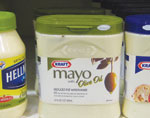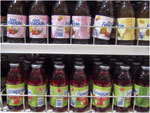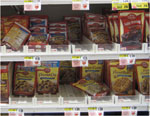
For years, we’ve advised marketers to ensure their packaging “breaks through shelf clutter” and facilitates shopping. That’s because our studies have consistently shown that visibility and shoppability are most predictive of in-market success.
But all it takes is one walk down a store aisle-whether it’s a Walmart in Texas, a kiosk in Jakarta or a hypermarket in Paris-to realize that we need to take our advice one step further. To ensure success, marketers must not only optimize visibility and shoppability but also how packaging actually appears on the shelf.
We’re speaking, of course, about a fundamental and nearly-universal truth: Packaging rarely appears as we’d like it to at retail. Instead, packages are frequently knocked over, facing sideways or backwards, partially obstructed, scrunched up or dented, or compromised by poor lighting or careless stocking.
What’s more, many marketers willfully ignore these “retail realities.” The situation is frequently dismissed as “beyond our control” or “different in every store” or simply, “someone else’s responsibility.”
But marketers can no longer afford to think and act this way. With more than two-thirds of purchase decisions made in-store-and with retailers increasingly focused on aggressively promoting their own store brands-ignoring “retail realities” is costing brands millions in forgone sales.
Tackling the situation becomes more manageable, though, when marketers think more systematically about the realities of the retail environment.

Packaging issues
To begin, there are the packaging issues-the result of packaging systems or structures that don’t always translate well to the retail environment.Consider rounded containers. They look great in the conference room (or when viewed in a focus group) when they face directly forward, but, in-store these containers are often turned off-center, which can greatly compromise their impact and communication. Bagged products can also be a challenge because they are likely to sag or get “scrunched” on shelf, which can impact quality perceptions and/or make key copy points (claims, variety, etc.) unreadable.
Sometimes, a packaging material can be a detriment, even if it was expressly intended as a consumer benefit. For example, many packages use a clear window to allow the shopper to view the product. However, when these windows are damaged-as is known to happen-the product becomes compromised and the result is a package that cannot be sold.
The visual impact of some colors is also a packaging challenge, particularly white or black packs because they are far more likely to be influenced by shelving, the quality of lighting and other elements of the retail environment.

Shelving issues
There are also considerable issues with the way packaging is presented within a category. Though marketers may not be able to control the shelf, they can anticipate the different possibilities and design accordingly.For example, a package’s location on shelf has a direct impact on how it is viewed by the shopper, and, as a result, the importance of different panels. If a package is typically placed on lower shelves (or within refrigerator wells), it is typically viewed downward which makes the top panel (or lid) the primary communication vehicle.
The way a category is organized also impacts packaging communication. In a category where private label is interspersed with national brands, the primary packaging challenge often becomes one of differentiation and the justification of a price premium. In brand-blocked categories, there is a greater need to visually pre-empt the competition and facilitate product selection within the brand.
Another shelving concern relates to the manner in which the category is actually stocked. For example, retailers often put out as much product as possible to save time and minimize stock-outs. Extra packages may be stuffed on shelf, leading to scrunched/compromised packs. Side or end panels may be featured (as is often the case in the pet aisle), which places greater importance for these panels to “sell” for the brand.
There’s also the unfortunate reality that some stores may fail to accurately follow any prescribed planogram-and, thus, may not place a brand’s packages in anticipated or desired adjacencies.

Merchandising issues
On a broader scale, there are other in-store variables that are cause for concern: product displays, signage and promotions, and retail environments are merchandising issues that can all dramatically impact packaging effectiveness.The presence of product or point-of-sale displays, for instance, can dramatically impact the role of packaging. Consider the various technology categories, where products are often displayed without packaging. When the shopper does reach for the packaging, it is to quickly and clearly confirm product specifications and compatibility (i.e., Will it work with my system?).
In these instances, it’s important that packages and in-store displays peacefully coexist, by complementing each other rather than replicating efforts. We’ve found that displays can be effective in driving shopper attention and conveying a strong brand message, while packages are typically better suited to conveying specific product benefits and facilitating shopping/selection.
Merchandising issues also include the many different physical impediments that can compromise packaging communication. These include shelf “lips” that can block the bottom portion of a package, shelf overhangs that can obstruct the top-or even freezer doors that often fog up and hinder package viewing.
Shopper issues
There are also underlying dynamics in the way shoppers interact with packaging. For instance, in many scent-driven categories (shampoos, fragrances, air fresheners, etc.), shoppers have a desire to smell the product. Unless that need is adequately addressed via displays, scratch and sniff packaging or another method, it can lead to many opened and rejected packages and, thus, high levels of shrinkage.There is also the reality that in some categories (such as batteries and OTC medications), there is a high likelihood of theft - and packaging needs to limit this risk, without sacrificing shelf presence and communication.
Of course, it can be overwhelming to try and consider each of these challenges in your package development efforts. However, we’ve found that there are typically two to three fundamental issues that drive the majority of problems in a given category. Thus, the solution is to identify the drivers in your category-and to explore packaging and merchandising innovations to mitigate these factors.
Four solutions
So where do you begin to ensure that your packaging is performing effectively in the “real world”? Here are four suggestions:1 Start with retail audits. Of course, nearly all designers (and hopefully most brand teams) regularly visit the store, particularly at the outset of initiatives. The question, however, is how they conduct these visits. Do they just “look around” to get a feel for the store environment, or do they systematically document these packaging, shelving, merchandising and shopper issues? Do they visit a range of retail channels to uncover the different challenges that exist in club stores and convenience stores, as opposed to grocery or mass? Do they visit different countries and/or speak with global colleagues, to understand the differences across markets?
We’d suggest a structured “store visit checklist” to ensure a systematic and comprehensive approach to documenting the challenges of the retail environment. We’d also recommend the involvement of an inter-disciplinary team, including members of marketing, design, sales, research and package engineering among others. Finally, we’d suggest bringing a digital camera along, as one picture is worth a thousand words in conveying these issues to senior management.
2 Design for the worst case scenario.Above all else, effective retail auditing should illustrate the importance of developing packaging that works in less than optimal conditions. This idea of “designing for the worst case scenario” should involve the selection of packaging structures/systems that are more likely to perform well at retail (i.e., to stay upright, minimize risk of breaking, etc.), along with graphic design that ensures each packaging panel is “selling” for the brand and facilitating shopping. The challenges of the retail environment need to be incorporated within design briefs-and built in to the design process (via the design of side panels, etc.).
3 Test in different contexts.It’s essential to measure on-shelf performance when assessing new packaging systems. And we recommend testing packaging in a variety of shelving scenarios: through alternative shelf placements (top shelf vs. bottom shelf) and alternative shelf arrangements (within a brand-block or interspersed with own brands); in different retail channels; and with different angles/panels showing and different merchandising setups.
In addition, it is helpful to supplement controlled or virtual tests with visits to the store, in order to place physical packs/comps on shelf as an additional “reality check.” In many cases, we’ve found that this extra “research”-literally placing a physical pack on a shelf-has provided insights that couldn’t be gathered through a virtual study.
4 Invest! And while it may be difficult to be reminded of this in these challenging times, marketers need to make investments to solve for these retail challenges.
Invest in packaging structures that limit retail risks and maximize opportunities. For example, the new square jar for Kraft mayonnaise makes it more likely that the front label will be facing out at retail-and also provides a functional benefit for users (making it easier to dispense the product).
Invest in shelving and merchandising systems that help control the retail environment and optimize packaging effectiveness. Perhaps the most notable recent example of this is Campbell’s, which created a new paradigm in the soup category with its gravity feed shelving unit. This system made the cans easier for retailers to stock and ensured a clear view of each Campbell’s variety, which facilitated the shopping process and drove incremental purchases and a positive ROI.
Invest in on-shelf research that takes different “retail realities” into account. We regularly find that shelf placement has a direct impact on visibility, findability and purchase levels. Thus, testing new packaging systems within several different retail shelving scenarios is a well-established best practice.
Comprehensive research also involves investments in physical packaging comps, to allow for testing on live shelf sets (rather than virtual shelves). In fact, an increasing number of clients are investing in “retail learning centers” that allow clients to regularly view packaging on shelf or within gondolas, as part of the development and assessment process.
If there is one definite “reality,” it’s that many of the most profitable investments are those tied to optimizing point-of-sale effectiveness. Therefore, marketers that develop the processes-and invest the resources-to understand, address and mitigate “retail realities” are sure to be well rewarded. BP
Scott Young and Jonathan Asher are with Perception Research Services (www.prsresearch.com), a company that conducts more than 700 annual consumer research studies to help marketers develop, assess and improve packaging systems. Reach Scott, president, at syoung@prsresearch.com and Jonathan, senior vice president, at jasher@prsresearch.com.
